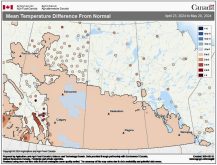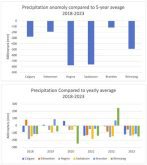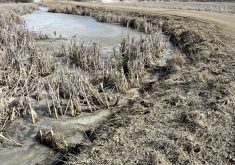For the most part I don’t think anyone could complain about the weather we experienced in September across most of agricultural Manitoba. Most people want to see a warm, dry September that allows late-season crops to mature and, more importantly, lets you get onto the land to bring in the harvest. Well, September 2013 brought plenty of heat and, for the most part, was pretty dry.
After a near-average summer it felt nice to see summer stick around for an extra month. After a miserable fall last year, things felt pretty darned good this year! Temperatures this September averaged about 3 C above the long-term average. Most days felt like summer was still around, as we saw about 20 days with highs greater than 20 C. We have to go back to 2009 to find a better September. In that year we had a very warm September with a mean temperature nearly 5 C above average. The difference between that year and this year will hopefully be the weather during October. In 2009, temperatures started to take a nosedive during the last couple of days of September and those cold temperatures continued right through most of October. This year it doesn’t look like we’ll follow the same trend.
Read Also

Understanding wind chill
How wind chill actually impacts how cold you feel this winter, plus gift ideas for the weather nerd in your life
September started off warm and got downright hot by the 5th or 6th of the month, when highs in a number of locations pushed into the low 30s. The warm weather continued for most of the month, with only a couple of days here and there that were on the cool side. Frost didn’t make much of an appearance this year during September, with only a few locations in central and eastern regions reporting frost on the morning of Sept. 16.
Precipitation during most of the month was fairly light overall. The first three weeks saw only a few scattered showers and a few rumbles of thunder push through, dropping only a couple of millimetres. A few localized areas did get some heavier showers or thundershowers, bringing some more significant amounts of rain, but these were mainly confined to western regions. Eastern regions did get some much-needed rain late in the month, as an area of low pressure slid through North Dakota and Minnesota, bringing a day-long soaking rain to those regions on Sept. 28. Amounts from that event ranged from about 10 mm near Portage and 20 mm near Winnipeg to as high as 95 mm around Sprague. Overall, when all the rain was added up, the Winnipeg region recorded around 30 mm of rain, about half the average. The Brandon region was even drier with only 20 mm of rain reported, well below its long-term average of 48 mm. The Dauphin region was the only area that recorded near-average amounts of rain. The two locations around Dauphin recorded 48 and 63 mm of rain, close to their average of 67 mm.
Who called it?
Overall, I think it is safe to say September 2013 had well-above-average temperatures along with below- to well-below-average amounts of rain. Looking back at the predictions made, it would appear both the Old Farmer’s Almanac and we here at the Co-operator called for near- to above-average temperatures. The Old Farmer’s Almanac called for below-average amounts of precipitation while I called for drier-than-average conditions to start off fall. To me this sounds like a tie. Now, can we both get it right for a second month in a row?
Well, the Old Farmer’s Almanac calls for October temperatures to continue to be slightly above average, along with a continuation of dry conditions. Over at the Canadian Farmers’ Almanac they are continuing to sing from the same songbook, with a call for cold and wet weather for much of October. Environment Canada seems to be in line with the Old Farmer’s Almanac as it too calls for above-average temperatures, but it forecasts near-average amounts of precipitation. Finally, here at the Co-operator, I am calling for the above-average temperatures to continue, with precipitation coming in near to slightly below average.
Next issue we’ll start to look at the latest release from the Intergovernmental Panel on Climate Change (IPCC), which puts out a comprehensive document every five to six years on the state of research and scientific understanding of the world’s climate. Stay tuned, as this topic tends to stir up as much controversy as discussions about sports, politics or religion!



















